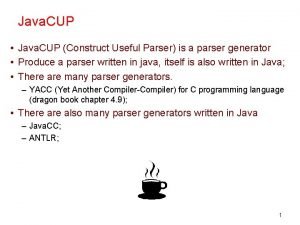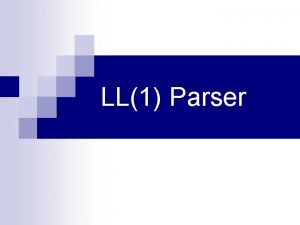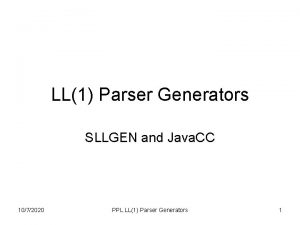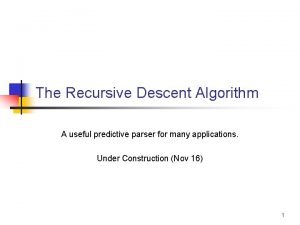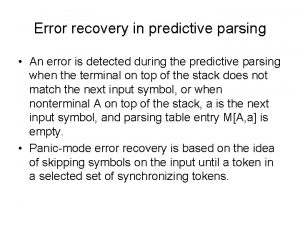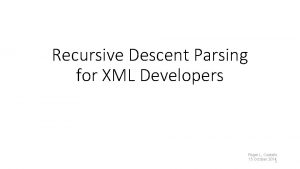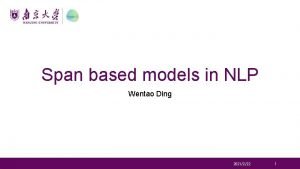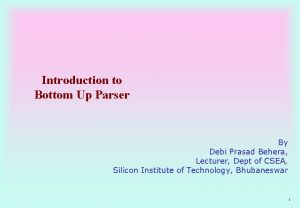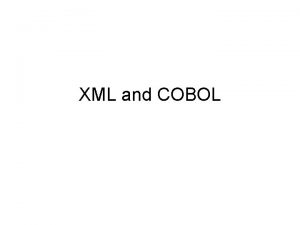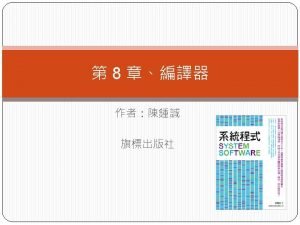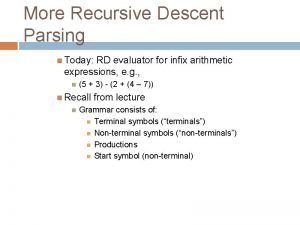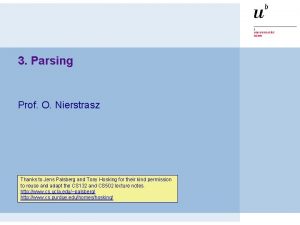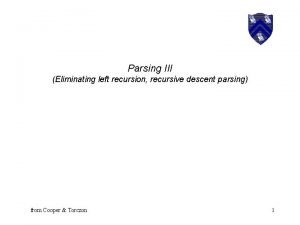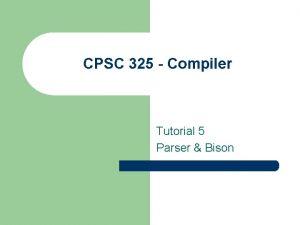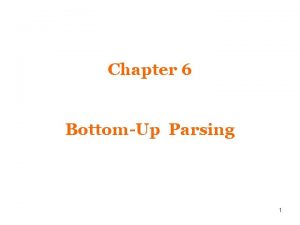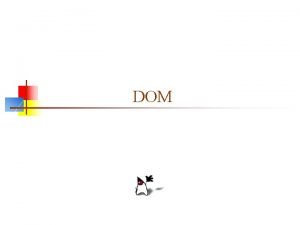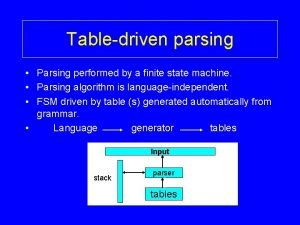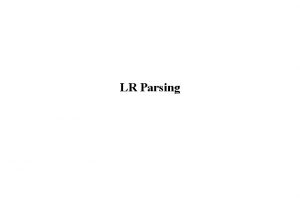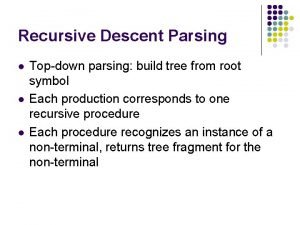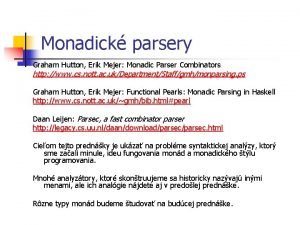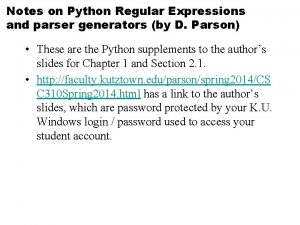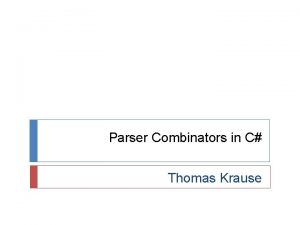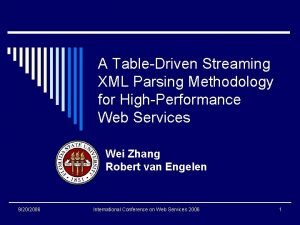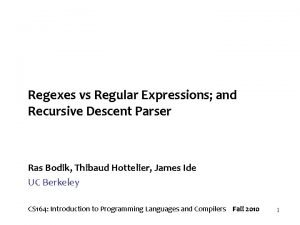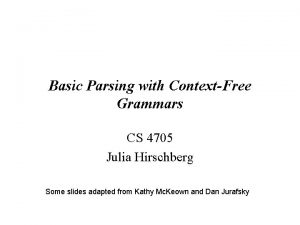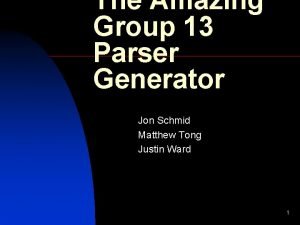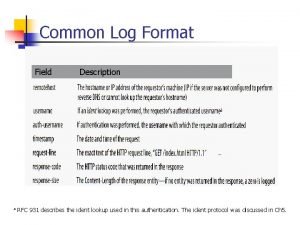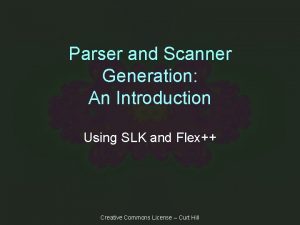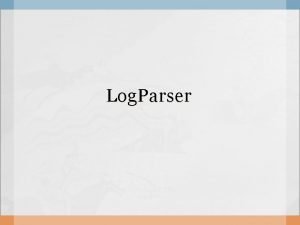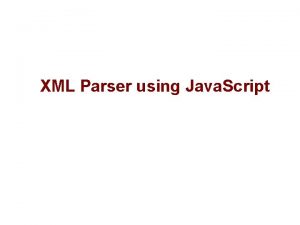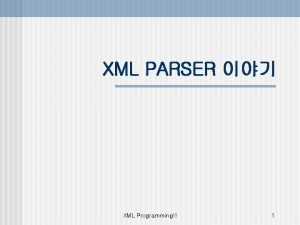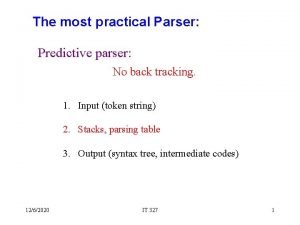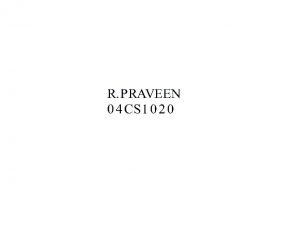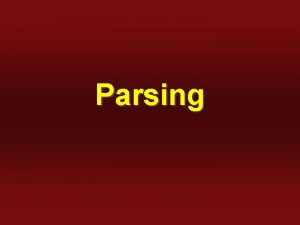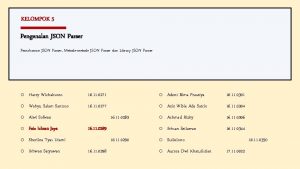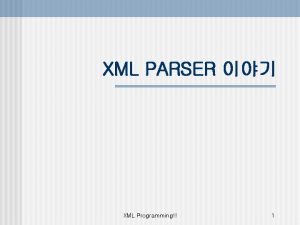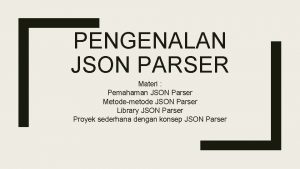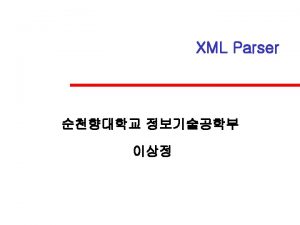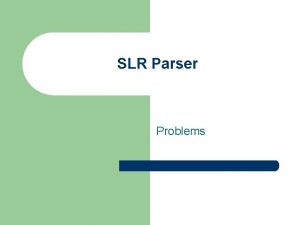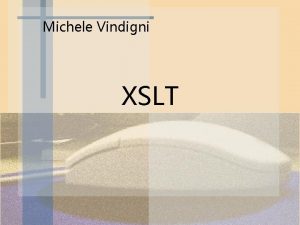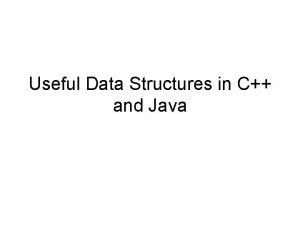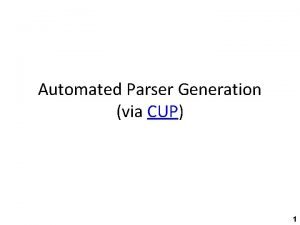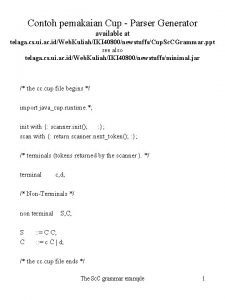Java CUP Java CUP Construct Useful Parser is




























![Calc 2 Parser User 1. class Program. Processor { 2. public static void main(String[] Calc 2 Parser User 1. class Program. Processor { 2. public static void main(String[]](https://slidetodoc.com/presentation_image_h/217a69127c5bb6ecbe9e570275485317/image-29.jpg)




- Slides: 33

Java. CUP • Java. CUP (Construct Useful Parser) is a parser generator • Produce a parser written in java, itself is also written in Java; • There are many parser generators. – YACC (Yet Another Compiler-Compiler) for C programming language (dragon book chapter 4. 9); • There also many parser generators written in Java – Java. CC; – ANTLR; 1

More on classification of java parser generators • Bottom up Parser Generators Tools – Java. CUP; – Sable. CC, The Sable Compiler www. sablecc. org • Topdown Parser Generators Tools – ANTLR, Another Tool for Language Recognition www. antlr. org – Java. CC, Java Compiler www. webgain. com/java_cc 2

What is a parser generator T o t a l : = p r i c e + t a x ; Scanner Total : = price + tax ; assignment id : = Parser Expr Exp + id Parser generator (Java. Cup) id Context Free Grammar 3

Steps to use Java. Cup • Write a java. Cup specification (cup file) – Defines the grammar and actions in a file (say, calc. cup) • Run java. Cup to generate a parser – java_cup. Main calc. cup – Notice the package prefix java_cup before Main; – Will generate parser. java and sym. java (default class names, which can be changed) • Write your program that uses the parser – For example, Use. Parser. java • Compile and run your program 4

Example 1: parse an expression and evaluate it • Grammar for arithmetic expression expr ‘+’ expr | expr ‘–’ expr | expr ‘*’ expr | expr ‘/’expr | ‘(‘expr’)’ | number • Example (2+4)*3 is an expression • Our tasks: – Tell whether an expression like “(2+4)*3” is syntactically correct; – Evaluate the expression (we are actually producing an interpreter for the “expression language”). 5

public interface Scanner { public Symbol next_token() throws java. lang. Exception; } The overall picture java_cup. runtime Scanner Symbol implements extends Calc. Parser Calc. Scanner expression Calc. Scanner tokens lr_parser Calc. Parser. User (2+4)*3 JLex calc. lex java. Cup result calc. cup 6

Calculator java. Cup specification (calc. cup) terminal PLUS, MINUS, TIMES, DIVIDE, LPAREN, RPAREN; terminal Integer NUMBER; non terminal Integer expr; precedence left PLUS, MINUS; precedence left TIMES, DIVIDE; expr : : = expr PLUS expr | expr MINUS expr | expr TIMES expr | expr DIVIDE expr | LPAREN expr RPAREN | NUMBER ; • Is the grammar ambiguous? • Add precedence and associativity – left means, that a + b + c is parsed as (a + b) + c – lowest precedence comes first, so a + b * c is parsed as a + (b * c) • How can we get PLUS, NUMBER, . . . ? – They are the terminals returned by the scanner. • How to connect with the scanner? 7

Ambiguous grammar error • If we enter the grammar as below: Expression : : = Expression PLUS Expression; • Without precedence Java. CUP will tell us: Shift/Reduce conflict found in state #4 between Expression : : = Expression PLUS Expression () and Expression : : = Expression () PLUS Expression under symbol PLUS Resolved in favor of shifting. • The grammar is ambiguous! • Telling Java. CUP that PLUS is left associative helps. 8

Corresponding scanner specification (calc. lex) 1. import java_cup. runtime. Symbol; 2. Import java_cup. runtime. Scanner; 3. %% 4. %implements java_cup. runtime. Scanner 5. %type Symbol 6. %function next_token 7. %class Calc. Scanner 8. %eofval{ return null; 9. %eofval} 10. NUMBER = [0 -9]+ 11. %% 12. "+" { return new Symbol(Calc. Symbol. PLUS); } 13. "-" { return new Symbol(Calc. Symbol. MINUS); } 14. "*" { return new Symbol(Calc. Symbol. TIMES); } 15. "/" { return new Symbol(Calc. Symbol. DIVIDE); } 16. {NUMBER} { return new Symbol(Calc. Symbol. NUMBER, new Integer(yytext())); } 17. r|n|. {} • Connection with the parser – – – imports java_cup. runtime. *, Symbol, Scanner. implements Scanner next_token: defined in Scanner interface Calc. Symbol, PLUS, MINUS, . . . new Integer(yytext()) 9

Run JLex D: 214>java JLex. Main calc. lex – note the package prefix JLex – program text generated: calc. lex. java D: 214>javac calc. lex. java – classes generated: Calc. Scanner. class 10

Generated Calc. Scanner class 1. 2. 3. 4. 5. 6. 7. 8. import java_cup. runtime. Symbol; Import java_cup. runtime. Scanner; class Calc. Scanner implements java_cup. runtime. Scanner {. . . . public Symbol next_token () {. . . case 3: { return new Symbol(Calc. Symbol. MINUS); } case 6: { return new Symbol(Calc. Symbol. NUMBER, new Integer(yytext())); } 9. . . . 10. } 11. } • Interface Scanner is defined in java_cup. runtime package public interface Scanner { public Symbol next_token() throws java. lang. Exception; } 11

Run java. Cup • Run java. Cup to generate the parser – D: 214>java_cup. Main -parser Calc. Parser -symbols Calc. Symbol calc. cup – classes generated: • Calc. Parser; • Calc. Symbol; • Compile the parser and relevant classes – D: 214>javac Calc. Parser. java Calc. Symbol. java Calc. Parser. User. java • Use the parser – D: 214>java Calc. Parser. User 12

The token class Symbol. java 10. public class Symbol { public int sym, left, right; public Object value; public Symbol(int id, int l, int r, Object o) { this(id); left = l; right = r; value = o; } public Symbol(int id, Object o) { this(id, -1, o); } public Symbol(int sym_num) {. . } public String to. String() { return "#"+sym; } } • Instance variables: 1. 2. 3. 4. 5. 6. 7. 8. 9. – – • sym: the symbol type; left: left position in the original input file; right: right position in the original input file; value: the lexical value. Recall the action in lex file: [0 -9]+ {return new Symbol(Calc. Symbol. NUMBER, new Integer(yytext())); } "+" { return new Symbol(Calc. Symbol. PLUS); } 13

Calc. Symbol. java (default name is sym. java) 1. public class Calc. Symbol { 2. public static final int MINUS = 3; 3. public static final int DIVIDE = 5; 4. public static final int NUMBER = 8; 5. public static final int EOF = 0; 6. public static final int PLUS = 2; 7. public static final int error = 1; 8. public static final int RPAREN = 7; 9. public static final int TIMES = 4; 10. public static final int LPAREN = 6; 11. } • Contain token declaration, one for each token (terminal); Generated from the terminal list in cup file – terminal PLUS, MINUS, TIMES, DIVIDE, LPAREN, RPAREN; – terminal Integer NUMBER • Used by scanner to refer to symbol types, e. g. , – return new Symbol(Calc. Symbol. PLUS); • Class name comes from –symbols directive. java_cup. Main -parser Calc. Parser -symbols Calc. Symbol calc. cup 14

The program that uses the Calc. Paser 1. import java. io. *; 2. class Calc. Parser. User { 3. public static void main(String[] args) throws IOException{ 4. File input. File = new File ("d: /214/calc. input"); 5. Calc. Parser parser= new Calc. Parser 6. (new Calc. Scanner(new File. Input. Stream(input. File))); 7. parser. parse(); 8. } 9. } • • The input text to be parsed can be any input stream (in this example it is a File. Input. Stream); The first step is to construct a parser object. A parser can be constructed using a scanner. – • this is how scanner and parser get connected. If there is no error report, the expression in the input file is correct. 15

Recap • To write a parser, how many things you need to write? – cup file; – lex file; – a program to use the parser; • To run a parser, how many things you need to do? – Run java. Cup, to generate the parser; – Run JLex, to generate the scanner; – Compile the scanner, the parser, the relevant classes, and the class using the parser; • relevant classes: Calc. Symbol, Symbol – Run the class that uses the parser. 16

Recap (cont. ) java_cup. runtime Scanner implements expression Calc. Scanner coded as Symbol use Calc. Symbol tokens lr_parser extends generate Calc. Parser. User 2+(3*5) JLex calc. lex java. Cup result calc. cup 17

Evaluate the expression • • • The previous specification only indicates the success or failure of a parser. No semantic action is associated with grammar rules. To calculate the expression, we must add java code in the grammar to carry out actions at various points. Form of the semantic action: expr: e 1 PLUS expr: e 2 {: RESULT=new Integer(e 1. int. Value()+ e 2. int. Value()); : } – – Actions (java code) are enclosed within a pair {: : }. Note that it is different from JLex action code bracket Labels e 1, e 2: the objects that represent the corresponding terminal or nonterminal; RESULT: The type of RESULT should be the same as the type of the corresponding non-terminals. e. g. , expr is of type Integer, so RESULT is of type integer. In the cup file, you need to specify expr is of Integer type. non terminal Integer expr; 18

Change the calc. cup 1. 2. 3. 4. 5. 6. 7. 8. 9. 10. 11. 12. 13. 14. 15. terminal PLUS, MINUS, TIMES, DIVIDE, LPAREN, RPAREN; terminal Integer NUMBER; non terminal Integer expr; precedence left PLUS, MINUS; precedence left TIMES, DIVIDE; expr: : = expr: e 1 PLUS expr: e 2 {: RESULT = new Integer(e 1. int. Value()+ e 2. int. Value()); | expr: e 1 MINUS expr: e 2 {: RESULT = new Integer(e 1. int. Value()- e 2. int. Value()); | expr: e 1 TIMES expr: e 2 {: RESULT = new Integer(e 1. int. Value()* e 2. int. Value()); | expr: e 1 DIVIDE expr: e 2 {: RESULT = new Integer(e 1. int. Value()/ e 2. int. Value()); | LPAREN expr: e RPAREN {: RESULT = e; : } | NUMBER: e {: RESULT= e; : } • • How do you guarantee NUMBER is of Integer type? Yytext() returns a String : } : } {NUMBER} { return new Symbol(Calc. Symbol. NUMBER, new Integer(yytext())); } 19

Change Calc. Paser. User 1. import java. io. *; 2. class Calc. Parser. User { 3. public static void main(String[] a) throws Exception{ 4. Calc. Parser parser= new Calc. Parser( 5. new Calc. Scanner(new File. Reader(“calc. input”))); 6. Integer result= (Integer)parser. parse(). value; 7. System. out. println("result is "+ result); 8. } 9. } • Why the result of parser(). value can be casted into an Integer? Can we cast that into other types? – This is determined by the type of expr, which is the head of the first production in java. Cup specification: non terminal Integer expr; 20

Calc: second round • Calc program syntax program statement | statement program statement assignment SEMI assignment ID EQUAL expr PLUS expr | expr MULTI expr | LPAREN expr RPAREN | NUMBER | ID • Example program: • X=1; y=2; z=x+y*2; • Task: generate and display the parse tree in XML 21

Abstract syntax tree X=1; y=2; z=x+y*2; Program Statement Assignment ID Expr NUMBER ID Expr ID NUMBER PLUS Expr ID Expr MULTI Expr ID NUMBER 22

OO Design Rationale • Write a class for every non-terminal – Program, Statement, Assignment, Expr • Write an abstract class for non-terminal which has alternatives – Given a rule: statement assignment | if. Statement – Statement should be an abstract class; – Assignment should extends Statement; • Semantic part of the CUP file will construct the object; – assignment : : = ID: e 1 EQUAL expr: e 2 {: RESULT = new Assignment(e 1, e 2); : } • The first rule will return the top level object (the Program object) – the result of parsing is a Program object • It is similar to XML DOM parser. 23

Calc 2. cup 1. terminal String ID, LPAREN, RPAREN, EQUAL, SEMI, PLUS, MULTI; 2. terminal Integer NUMBER; 3. non terminal Expr expr; 4. non terminal Statement statement; 5. non terminal Program program; 6. non terminal Assignment assignment; 7. precedence left PLUS; 8. precedence left MULTI; 9. program : : = statement: e {: RESULT = new Program(e); : } 10. | statement: e 1 program: e 2 {: RESULT=new Program(e 1, e 2); : }; 11. statement : : = assignment: e SEMI {: RESULT = e; : } ; 12. assignment: : = ID: e 1 EQUAL expr: e 2 13. {: RESULT = new Assignment(e 1, e 2); : }; 14. expr : : = expr: e 1 PLUS: e expr: e 2 {: RESULT=new Expr(e 1, e 2, e); : } 15. | expr: e 1 MULTI: e expr: e 2 {: RESULT=new Expr(e 1, e 2, e); : } 16. | LPAREN expr: e RPAREN {: RESULT = e; : } 17. | NUMBER: e {: RESULT= new Expr(e); : } 18. | ID: e {: RESULT = new Expr(e); : } 19. ; • Common bugs in assignments: ; {: : } 24

Program class 1. import java. util. *; 2. public class Program { 3. private Vector statements; 4. public Program(Statement s) { 5. statements = new Vector(); 6. statements. add(s); 7. } 8. public Program(Statement s, Program p) { 9. statements = p. get. Statements(); 10. statements. add(s); 11. } 12. public Vector get. Statements(){ return statements; } 13. public String to. XML() {. . . } 14. } Program : : = statement: e {: RESULT=new Program(e); : } | statement: e 1 program: e 2 {: RESULT=new Program(e 1, e 2); : } 25

Assignment statement class 1. class Assignment extends Statement{ 2. private String lhs; 3. private Expr rhs; 4. public Assignment(String l, Expr r){ 5. lhs=l; 6. rhs=r; 7. } 8. String to. XML(){ 9. String result="<Assignment>"; 10. result += "<lhs>" + lhs + "</lhs>"; 11. result += rhs. to. XML(); 12. result += "</Assignment>"; 13. return result; 14. } 15. } assignment: : =ID: e 1 EQUAL expr: e 2 {: RESULT = new Assignment(e 1, e 2); : } 26

Expr class 1. public class Expr { 2. private int value; 3. private String id; 4. private Expr left; 5. private Expr right; 6. private String op; 7. public Expr(Expr l, Expr r, String o){ left=l; right=r; op=o; } 8. public Expr(Integer i){ value=i. int. Value(); } 9. public Expr(String i){ id=i; } 10. public String to. XML() { . . . } 11. } expr: : = expr: e 1 PLUS: e expr: e 2 {: RESULT = new Expr(e 1, e 2, e); : } | expr: e 1 MULTI: e expr: e 2 {: RESULT = new Expr(e 1, e 2, e); : } | LPAREN expr: e RPAREN {: RESULT = e; : } | NUMBER: e {: RESULT= new Expr(e); : } | ID: e {: RESULT = new Expr(e); : } 27

Calc 2. lex 1. 2. 3. 4. 5. 6. 7. 8. 9. 10. 11. 12. 13. 14. 15. 16. 17. 18. 19. import java_cup. runtime. *; %% %implements java_cup. runtime. Scanner %type Symbol %function next_token %class Calc 2 Scanner %eofval{ return null; %eofval} IDENTIFIER = [a-z. A-Z][a-z. A-Z 0 -9_]* NUMBER = [0 -9]+ %% "+" { return new Symbol(Calc 2 Symbol. PLUS, yytext()); } "*" { return new Symbol(Calc 2 Symbol. MULTI, yytext()); } "=" { return new Symbol(Calc 2 Symbol. EQUAL, yytext()); } "; " { return new Symbol(Calc 2 Symbol. SEMI, yytext()); } "(" { return new Symbol(Calc 2 Symbol. LPAREN, yytext()); } ")" { return new Symbol(Calc 2 Symbol. RPAREN, yytext()); } {IDENTIFIER} {return new Symbol(Calc 2 Symbol. ID, yytext()); } {NUMBER} { return new Symbol(Calc 2 Symbol. NUMBER, new Integer(yytext())); } 20. n|r|. { } 28
![Calc 2 Parser User 1 class Program Processor 2 public static void mainString Calc 2 Parser User 1. class Program. Processor { 2. public static void main(String[]](https://slidetodoc.com/presentation_image_h/217a69127c5bb6ecbe9e570275485317/image-29.jpg)
Calc 2 Parser User 1. class Program. Processor { 2. public static void main(String[] args) throws IOException{ 3. File input. File = new File ("d: /214/calc 2. input"); 4. Calc 2 Parser parser= new Calc 2 Parser( 5. new Calc 2 Scanner(new File. Input. Stream(input. File))); 6. Program pm= (Program)parser. debug_parse(). value; 7. String xml=pm. to. XML(); 8. System. out. println("result is "+ xml); 9. } 10. } • Debug_parser(): print out debug info, such as the current token being processed, the rule being applied. – Useful to debug javacup specification. • Parsing result value is of Program type—this is decided by the type of the program rule: Program : : = statement: e {: RESULT = new Program(e); : } | statement: e 1 program: e 2 {: RESULT=new Program(e 1, e 2); : } ; 29

Another way to define the expression syntax terminal PLUS, MINUS, TIMES, DIV, LPAREN, RPAREN; terminal NUMLIT; non terminal Expression, Term, Factor; start with Expression; Expression : : = Expression PLUS Term | Expression MINUS Term | Term ; Term : : = Term TIMES Factor | Term DIV Factor | Factor ; Factor : : = NUMLIT | LPAREN Expression RPAREN ; 30

Debug the grammar import java. io. *; class A 3 User { public static void main(String[] args) throws Exception { File input. File = new File ("A 3. tiny"); A 3 Parser parser= new A 3 Parser(new A 3 Scanner(new File. Input. Stream(input. File))); Integer result =(Integer)parser. debug_parse(). value; File. Writer fw=new File. Writer(new File("A 3. output")); fw. write("Number of methods: "+ result. int. Value()); fw. close(); } } Parser will print out processed symbols and the current symbol that is causing the problem 31

Run all the programs using one command • Save the following into a file: java JLex. Main A 3. lex java_cup. Main -parser A 3 Parser -symbols A 3 Symbol < A 3. cup javac A 3. lex. java A 3 Parser. java A 3 Symbol. java A 3 User • Under unix – Can be any file name. say run 214 – Type: “chmod 755 run 214” – Type “run 214” • Under windows – Save as “run 214. bat” – Type “run 214” • It is script programming 32

More flexible • Script program (say named run 214) java JLex. Main $1. lex mv $1. lex. java $1 Scanner. java_cup. Main -parser $1 Parser -symbols $1 Symbol A 3 Lu. cup javac $1 Scanner. java A 3 Parser. java A 3 Symbol. java A 3 User. java $1 User more $1. output • Run the scrip program with parameter > run 214 A 3 33
 Java cup example
Java cup example Ll1 parsing
Ll1 parsing Ll(1) parser generator
Ll(1) parser generator Recursive descent parser c
Recursive descent parser c Recursive descent parser java
Recursive descent parser java Error recovery in predictive parsing
Error recovery in predictive parsing Limitations of recursive descent parser
Limitations of recursive descent parser Model span
Model span Bottom up parser
Bottom up parser Xml parser cobol
Xml parser cobol Lexer parser
Lexer parser Rd parser
Rd parser The role of the parser
The role of the parser Left recursion and left factoring
Left recursion and left factoring Bison tutorial
Bison tutorial Slr
Slr Lalr bottom up parser
Lalr bottom up parser Difference between sax and dom
Difference between sax and dom State machine parser
State machine parser Lr parsing example
Lr parsing example Recursive descent parser
Recursive descent parser Irony c#
Irony c# Windows dns log analyzer
Windows dns log analyzer сервера под a-parser
сервера под a-parser Parsery
Parsery Python re generator
Python re generator C# parser combinator
C# parser combinator Streaming xml parser
Streaming xml parser Recursive descent parser
Recursive descent parser Julia parser
Julia parser Jon parser
Jon parser Common log formats
Common log formats Log parser studio
Log parser studio Slk parser
Slk parser
